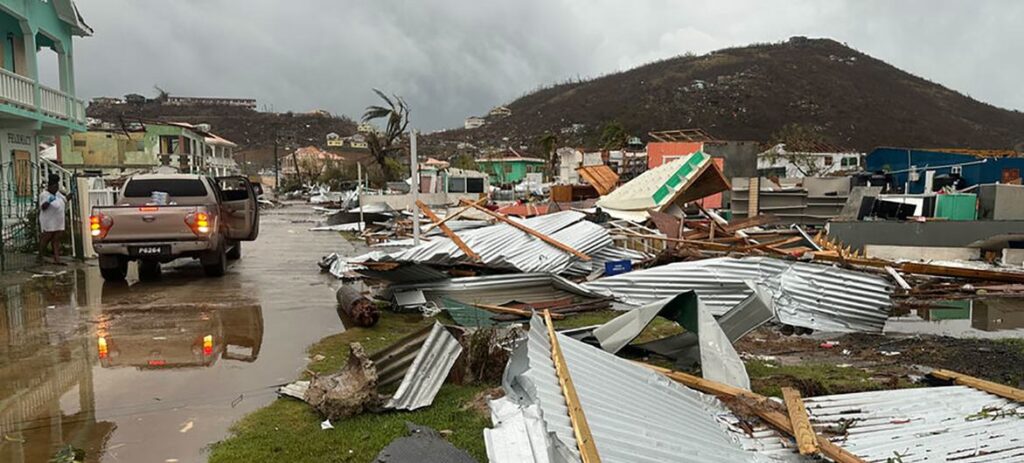Simon Springett, UN coordinator for Barbados and the Eastern Caribbean, spoke via video link from Grenada about a scene of total devastation in Carriacou, where Beryl first made landfall on July 1.
“The entire island is completely affected… that is literally 100 percent of the population,” he stressed.
Hurricane Beryl is the strongest hurricane in history to form in June in the Atlantic Ocean. Initially a tropical depression, it quickly intensified to a Category 4 storm and briefly reached Category 5 status, with winds of up to 240 km/h (150 mph).
The storm made landfall on Friday morning (New York time) in Mexico’s Yucatán Peninsula and is reportedly moving in a west-northwesterly direction. The storm is expected to make landfall in southern Texas, United States, on Monday morning.
‘Very complicated crisis’
Mr Springett stressed the situation as a “very complicated crisis”, characterised by serious logistical and access problems.
Four days after the hurricane struck, roads on the island are impassable and communications were only restored last night, he said.
“Immediately after the hurricane, the seas were exceptionally rough, making it almost impossible to get there. The air traffic control towers are down – so there’s only fly-by visibility. But even when the goods get to the airport, there are no roads to get to the goods.”

© WFP/Fedel Mansour
Residents of Union Island in Saint Vincent and the Grenadines prepare to board a ferry to a shelter after Hurricane Beryl.
International response
Countries near and far are sending aid. A French ship arrived in Carriacou later in the day, and aid also arrived from Guyana and Trinidad and Tobago, Mr Springett said.
“We have a big outpouring of international response “…it is truly an international effort, and the UN is very proud to be part of it,” he said.
Dennis Zulu, the Resident Coordinator for Jamaica and the Bahamas, also spoke via video link from the Bahamas about international cooperation.
He stressed that the UN is working with the Caribbean Disaster Emergency Management Agency (CDEMA), the regional emergency and disaster management agency, to ensure a coherent regional response.
“We stand ready to mount a coordinated humanitarian response with the international development partner community and are already engaging international partners and organizations in Jamaica,” he added.
Wide damage
Mr Zulu said a detailed assessment of the damage in Jamaica and other island states, which his office is supporting, is still ongoing.
“The damage is visible everywhere and is being felt by people from all walks of life, particularly in rural Jamaica, including the southern parishes of Clarendon, Manchester and Saint Elizabeth, and by those living in vulnerable housing,” he added.
He also noted that the Government of Jamaica has put in place an effective response plan, supported by the UN and partners, which includes shelters for people who have lost their homes.
Other important requirements include clean drinking water, access to communications and data, and livelihood support.

© UNICEF/Sam Ogilvie
A family stands in front of their home destroyed by Hurricane Beryl in Grenada.
‘Promise to be there for children’
According to the UN Children’s Fund (UNICEF), more than 650,000 people – including 150,000 children – in Barbados, Grenada, Saint Lucia, Saint Vincent and the Grenadines and Tobago were in the path of Hurricane Beryl.
Many have lost their homes and are staying in temporary shelters.
The UN agency, in turn, had life-saving supplies ready before the storm and is now mobilizing resources and money for the response.
“(We are) deeply concerned about the plight of those affected by Hurricane Beryl, especially the most vulnerable – children and women… we pledge to be there for the children of the affected countries,” said Pieter Bult, UNICEF Representative for the Eastern Caribbean.
Similarly, the UN World Food Programme (World Food Programme) has also sent teams to the affected islands to support authorities with assessments and rapid response.
In Saint Vincent and the Grenadines, the agency has been asked to provide emergency assistance in the areas of telecommunications and logistics, while in Barbados it is helping with emergency food packages that are being sent and distributed to people on the affected islands.
‘Very intense’ hurricane season coming
Earlier in the day in Geneva, Vanessa Huguenin, spokeswoman for the UN Office for the Coordination of Humanitarian Affairs (OCHA), said that while humanitarian organizations are preparing for this hurricane season, “such a major storm this early in the year is extremely rare.”
“It is also a warning of the expected very intense hurricane season that is coming,” she said during the regular press conference at the UN Office in Geneva (UNOG).
The Atlantic storm season runs from June to late November, with 17 to 25 named storms expected. The average is 14 storms per year.
Of these organizations, the UN World Meteorological Organization (WMO) said eight to 13 hurricanes are expected to develop — more than the average of seven — including four to seven major hurricanes.
A major hurricane is a category three, four or five hurricane on the Saffir Simpson scale, with winds of 110 mph (177 km/h) or greater.
“This new reality of unprecedented hurricanes is becoming an annual and ubiquitous reality for Caribbean countries, while they are also among the hardest hit by climate change,” said Rhea Pierre, disaster manager at the International Federation of Red Cross and Red Crescent Societies (IFRC).
“The severity of the damage from Hurricane Beryl is palpable and devastating.”







